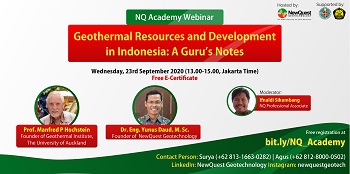NEWS
WKP Tangkuban Perahu, Developing Geothermal in Volcano Tourism Location
NQ News, Monday October 26, 2020
Mount Tangkuban Perahu is located in West Java Province between Bandung and Subang cities, among its manifestations are including craters, fumaroles, steaming ground, silica sinter, and hydrothermal alteration.
West Java is a province with the largest geothermal potential in Indonesia, which is around 5.4 GW, equivalent to 20% of the national potential. From 2.1 GW geothermal installed capacity, there are 1.2 GW which are produced in West Java from 7 fields, namely: Kamojang, Darajat, Awibengkok Salak, Wayang Windu, Patuha, and Karaha Bodas.
In 2017 the government assigned PLN to manage the Tangkuban Parahu WKP and was assigned the management to PLN.
PLN through NewQuest Geotechnology has just completed data and information enhancement activities, includes: Remote Sensing Analysis, Reprocessing and 3-D Modeling of Existing MT-Gravity Data, Geological Mapping and Rock Analysis, Geochemical Studies and Water/Gas/Isotope Analysis, Geophysical Survey (Gravity, MT, and TDEM), Conceptual Modeling and Resources Assessment, Well Targeting, Well Pad Selection, and Drilling Design, Infrastructure Design (Access Road, Well Pad, Water Distribution System), Power Plant Design (Process Flow Diagram, Technology Selection), FCRS Design, Transmission Line, Economic and Financial Evaluation.
Tangkuban Perahu with a potential of 100 MW will be developed 60 MW, COD target is on 2024 (RUPTL 2019). Tangkuban Perahu is one of the most popular volcano tourism areas in Indonesia with very easy and supportive access. Last activity of this Mountain is a phreatic eruption (hydrothermal eruption) recorded in July 2019 with a high ash column from the top of the mountain about 200 meters, or about 2,284 meters above sea level. Tangkuban Parahu's visit rate is high with around 1.4 million tourists in 2018, 64,000 of whom are foreign tourists.
According to Indonesian Vulcanology (vsi.esdm.go.id), the Tangkuban Perahu eruption has always been classified as a minor eruption. Since erupting for the first time in 1829, it has only erupted steam/ hot water and ash without being followed by melting lava, hot clouds or throwing incandescent rock.
PLN will immediately appoint partners for the development of this WKP, while interested parties can form a consortium with selected partners.


Gravity Survey and Magnetotelluric Data Processing of Jailolo Geothermal Prospect Area, West Halmahera
NQ News, Monday, 11 April 2022

Press Release: NewQuest Geotechnology Anniversary Day - A Ten Years of Contributions
NQ News, Monday, 25 of October 2021

SPECIAL NQ 10 YEARS ANNIVERSARY DAY “Geothermal Technology Innovations: A Perspective from...
NQ News, Thursday, 21st of October 2021

Special NQ Training: “Magnetotelluric (MT) for Geothermal Exploration”
NQ News, Monday, 4 October 2021

Special NQ Training For Public Society: “Geothermal Energy: A Special Gift for Indonesia”
NQ News, Thursday, 30 September 2021

Review of Special NQ Academy Webinar #10: Technology & Innovation to Accomplish Geothermal...
NQ News, Thursday, 16 September 2021

NQ Ten Years Anniversary: Contributions for National Prosperity Through Continuous Innovations
NQ News, Tuesday, 1 September 2021

NQ Academy Webinar #10: Technology & Innovation to Accomplish Geothermal as Affordable Energy
NQ News, Tuesday, 1 September 2021

Review of NQ Academy Webinar #9: Steam Field Management: Problems and Troubleshootings
NQ News, Monday, 16 August 2021

NQ Academy Webinar #9: Steam Field Management: Problems and Troubleshooting
NQ News, Friday, 30 Juli, 2021

GEOTHERMAL MEDIUM TEMPERATURE RESOURCES IN MALAYSIA, THAILAND AND INDONESIA
NQ News, Wednesday, May 5, 2021

Review of NQ Academy Webinar #8: Lessons Learned from Geothermal Exploration in Muara Laboh
NQ News, Monday, May 3, 2021

NQ and IMT-GT Webinar on Exploration & Utilisation of Low-Medium Geothermal Resources...
NQ News, Friday, April 23, 2021

NQ Academy Webinar #8: Lessons Learned from Geothermal Exploration in Muara Laboh
NQ News, Wednesday, April 21, 2021

Review of NQ Academy Webinar #7: Geothermal Production Processes through Geochemical Interventions
NQ News, Thursday, April 1, 2021

NQ Academy Webinar #7: Optimization of Geothermal Production Processes through Geochemical Interventions for ...
NQ News, Thursday, March 25, 2021

Review of NQ Academy Webinar #6: From Large-Scale Tectonics to Field-Scale Geothermal Systems
NQ News, Wednesday, March 3, 2021

NQ Academy Webinar #6: From Large-Scale Tectonics to Field-Scale Geothermal System: Lessons Learned from Sumatra
Thursday, February 25, 2021

Review of NQ Academy Webinar #5: Final Preparation of Government Drilling Program
NQ News, Friday, February 5, 2021

WKP Cisolok Cisukarame: First WKP to drill in Government Drilling Program
NQ News, Tuesday, February 2, 2021

Review of NQ Academy Webinar #4: Geochemical Signatures over Volcanic Geothermal Systems
NQ News, Wednesday, December 23, 2020

NQ ACADEMY WEBINAR #4: Geochemical Signatures over Volcanic Geothermal Systems
NQ News, Wednesday, December 16, 2020

The Three Million Dollars Well: A Lesson Learned from Geothermal Drilling in Indonesia
NQ News, Monday December 7, 2020

NewQuest Geotechnology & North Tech Drilling Signed a Strategic Partnership Agreement
Press Release: Monday November 30, 2020

NQ ACADEMY WEBINAR #3: THE THREE MILLION DOLLAR WELL: A LESSON LEARNED FROM ...
NQ News, Thursday November 19, 2020

NQ SURVEY AND EXPLORATION IN MALAYSIA AND PROSPECTS FOR GEOTHERMAL DEVELOPMENT ...
NQ News, Monday November 16, 2020

"BEST GEOTHERMAL SERVICES COMPANY" AWARD FOR NEWQUEST GEOTECHNOLOGY
NQ News, Wednesday September 30, 2020

WKP ATADEI, A PARTNERSHIP OPPORTUNITIES ON PLN’s GEOTHERMAL WORKING AREA (WKP)
NQ News, Monday September 28, 2020

DR. YUNUS DAUD LAUNCH NQ ACADEMY ON THE 1ST NQ ACADEMY WEBINAR EVENT
NQ News, Friday September 25, 2020

NewQuest footprint in Blawan - Ijen WKP, First Discovery of hidden geothermal in Indonesia
NQ News, Friday August 21, 2020

RI "Too Preoccupied" with Fossil Energy, Renewable Energy Should Be Accelerated
Friday, 3 February 2017




















